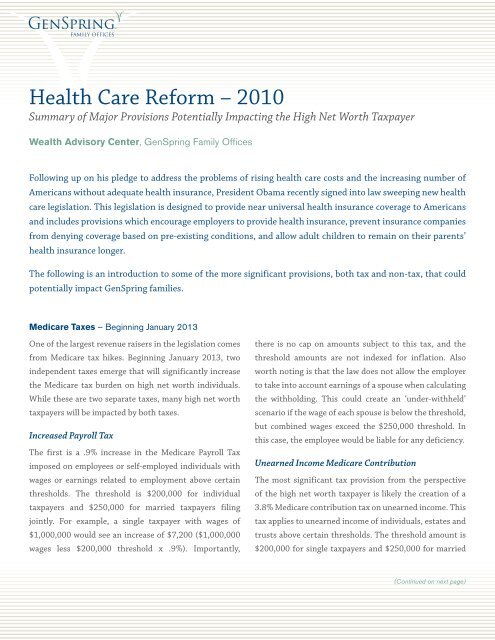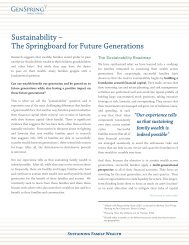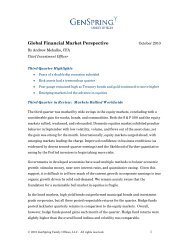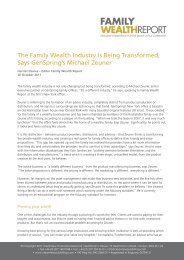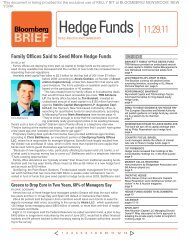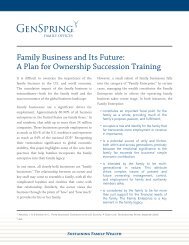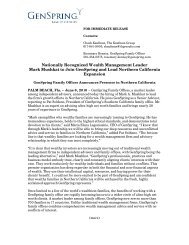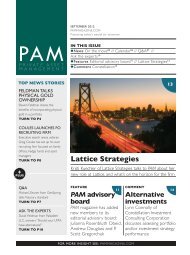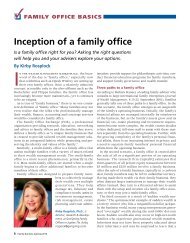Health Care Reform – 2010 - GenSpring Family Offices
Health Care Reform – 2010 - GenSpring Family Offices
Health Care Reform – 2010 - GenSpring Family Offices
You also want an ePaper? Increase the reach of your titles
YUMPU automatically turns print PDFs into web optimized ePapers that Google loves.
<strong>Health</strong> <strong>Care</strong> <strong>Reform</strong> <strong>–</strong> <strong>2010</strong><br />
Summary of Major Provisions Potentially Impacting the High Net Worth Taxpayer<br />
Wealth Advisory Center, <strong>GenSpring</strong> <strong>Family</strong> <strong>Offices</strong><br />
Following up on his pledge to address the problems of rising health care costs and the increasing number of<br />
Americans without adequate health insurance, President Obama recently signed into law sweeping new health<br />
care legislation. This legislation is designed to provide near universal health insurance coverage to Americans<br />
and includes provisions which encourage employers to provide health insurance, prevent insurance companies<br />
from denying coverage based on pre-existing conditions, and allow adult children to remain on their parents’<br />
health insurance longer.<br />
The following is an introduction to some of the more significant provisions, both tax and non-tax, that could<br />
potentially impact <strong>GenSpring</strong> families.<br />
Medicare Taxes <strong>–</strong> Beginning January 2013<br />
One of the largest revenue raisers in the legislation comes<br />
from Medicare tax hikes. Beginning January 2013, two<br />
independent taxes emerge that will significantly increase<br />
the Medicare tax burden on high net worth individuals.<br />
While these are two separate taxes, many high net worth<br />
taxpayers will be impacted by both taxes.<br />
Increased Payroll Tax<br />
The first is a .9% increase in the Medicare Payroll Tax<br />
imposed on employees or self-employed individuals with<br />
wages or earnings related to employment above certain<br />
thresholds. The threshold is $200,000 for individual<br />
taxpayers and $250,000 for married taxpayers filing<br />
jointly. For example, a single taxpayer with wages of<br />
$1,000,000 would see an increase of $7,200 ($1,000,000<br />
wages less $200,000 threshold x .9%). Importantly,<br />
there is no cap on amounts subject to this tax, and the<br />
threshold amounts are not indexed for inflation. Also<br />
worth noting is that the law does not allow the employer<br />
to take into account earnings of a spouse when calculating<br />
the withholding. This could create an ‘under-withheld’<br />
scenario if the wage of each spouse is below the threshold,<br />
but combined wages exceed the $250,000 threshold. In<br />
this case, the employee would be liable for any deficiency.<br />
Unearned Income Medicare Contribution<br />
The most significant tax provision from the perspective<br />
of the high net worth taxpayer is likely the creation of a<br />
3.8% Medicare contribution tax on unearned income. This<br />
tax applies to unearned income of individuals, estates and<br />
trusts above certain thresholds. The threshold amount is<br />
$200,000 for single taxpayers and $250,000 for married<br />
(Continued on next page)
taxpayers filing jointly, and these amounts are not<br />
indexed for inflation. The tax is equal to 3.8% of the<br />
lesser of (1) the taxpayer’s “net investment income”, or<br />
(2) the excess of “modified adjusted gross income” over<br />
the threshold amount. “Net investment income” includes<br />
interest, dividends, annuities, rents, royalties, income<br />
derived from passive activities and net capital gains<br />
derived from the disposition of property (excluding<br />
property held in an active trade or business). Notably<br />
absent from this definition are distributions from IRAs<br />
or qualified plans and tax-exempt income such as<br />
municipal bond interest. 1 The following are three examples<br />
of how these concepts apply to individual taxpayers:<br />
Example 1:<br />
In 2013 a single taxpayer has the following items of income:<br />
$100,000 Net Investment Income<br />
$120,000 Salary<br />
$220,000 Modified Adjusted Gross Income (MAGI)<br />
The unearned income medicare contribution would only apply on the $20,000 amount by which her<br />
MAGI exceeds her threshold amount of $200,000, because that is less than her net investment income of<br />
$100,000. Thus, the tax would equal $760 ($20,000 × 3.8%).<br />
Example 2:<br />
In 2013 a single taxpayer has the following items of income:<br />
$100,000 Net Investment Income<br />
$200,000 Salary<br />
$300,000 Modified Adjusted Gross Income (MAGI)<br />
Because taxpayer’s MAGI exceeds her threshold amount by $100,000, she would pay a surtax on her<br />
full $100,000 of net investment income. Thus, the tax would equal $3,800 ($100,000 × 3.8%).<br />
Example 3:<br />
In 2013 a single taxpayer has the following items of income:<br />
$1,000,000 Net Investment Income<br />
$100,000 Salary<br />
$1,100,000 Modified Adjusted Gross Income (MAGI)<br />
Taxpayer would pay a surtax on the amount by which the MAGI exceeded the threshold amount because this<br />
amount is less than her net investment alone. Thus, tax would be $34,200 ($900,000 x 3.8%).<br />
1 Although distributions from IRAs and qualified plans are not considered “net investment income” and will therefore not be subject to the 3.8% surtax, distributions from<br />
traditional IRAs and qualified plans are included in “modified adjusted income” potentially increasing it over the threshold amount. Note distributions from Roth IRAs are<br />
not included in modified adjusted gross income.
This tax applies similarly to the unearned income of<br />
trusts and estates, except that the threshold amount is<br />
set equal to the dollar amount at which the highest estate<br />
and trust income tax bracket begins, currently $11,200.<br />
Note this lower threshold amount makes the 3.8% surtax<br />
more punitive for trusts and estates than for individual<br />
taxpayers. Trusts that distribute all current income will<br />
likely not be impacted since they would have no “net<br />
investment income.” Instead, the tax would apply at the<br />
beneficiary level according to the individual rules discussed<br />
above. Similarly, there should be no trust level surtax for<br />
trusts treated as “grantor trusts” for federal income tax<br />
purposes. Instead, the surtax should apply to the grantor<br />
under the individual rules discussed above. 2<br />
Individual <strong>Health</strong> Insurance Mandate<br />
Beginning January 2014, individuals must obtain and<br />
keep “minimum essential coverage” to avoid a penalty.<br />
This coverage can come from either eligible government<br />
programs (for example Medicare or Medicaid) or any plan<br />
offered in the marketplace. Lower income individuals as<br />
well as some middle income families may qualify for a<br />
premium assistance tax credit, cost sharing arrangements<br />
or vouchers to help pay for the health insurance.<br />
Immediate Changes to Employer Sponsored<br />
Group <strong>Health</strong> Insurance Plans<br />
Beginning in late <strong>2010</strong>, the law requires a number of<br />
plan design changes to employer provided group health<br />
insurance plans. Perhaps most significantly, the law requires<br />
these plans to eliminate both lifetime and annual limits on<br />
benefits. The law also creates a temporary national pool<br />
for people denied insurance due to preexisting conditions.<br />
Covered plans will also be required to cover the first-dollar<br />
spent on preventative care. Finally, covered plans that<br />
provide coverage for a dependent child must cover the<br />
child until he or she reaches age 26. 3<br />
Medical Expense Deduction<br />
Under current law, for regular income tax purposes, an<br />
individual who itemizes deductions can deduct certain<br />
unreimbursed medical expenses paid during the year to the<br />
extent they exceed a threshold amount of 7.5% of adjusted<br />
gross income. For Alternative Minimum Tax Purposes, the<br />
threshold is 10% of adjusted gross income. Given these<br />
thresholds, it is rare for high net worth or high income<br />
taxpayers to deduct unreimbursed medical expenses.<br />
Beginning in January 2013 the law raises the threshold<br />
for regular tax purposes to 10% of adjusted gross income.<br />
It does not change the rules for Alternative Minimum<br />
Tax purposes. Also note that special rules keep the<br />
threshold at 7.5% for 2013 through 2016 if the taxpayer<br />
or the taxpayer’s spouse turns 65 during the tax year.<br />
This change will make it more difficult for high net<br />
worth or high income taxpayers to deduct unreimbursed<br />
medical expenses.<br />
Flexible Spending Account Changes<br />
Beginning in January 2011, the law modifies the definition<br />
of qualified medical expenses to exclude over-the-counter<br />
medications that were allowed under prior law, and<br />
increases the additional tax on non-qualified distributions<br />
from 10% to 20%. Beginning in 2013, the legislation<br />
limits contributions to Flexible Spending Accounts (FSAs)<br />
to $2,500 per tax year.<br />
(Continued on next page)<br />
2 Charitable Remainder Trusts (CRTs) and tax-exempt trusts are excluded from the surtax.<br />
3 Note there is no requirement for a plan or issuer to provide health insurance coverage for anyone, including dependents. But if coverage is provided for dependent children,<br />
then the coverage must continue until the dependent child turns 26.
We have focused this discussion primarily on how this legislation impacts the high net worth individual.<br />
Keep in mind that the legislation also has major implications for both small and large businesses,<br />
non-profit hospitals, pharmaceutical importers and manufactures, medical device manufacturers and<br />
healthcare providers. We will continue to monitor and digest these provisions as they are phased in over<br />
the next several years. If you have questions regarding how these provisions may impact you or your<br />
business please contact your <strong>GenSpring</strong> advisor.<br />
Disclaimers<br />
This discussion is general in nature and is subject to change. Consult with your tax advisors before taking specific action.<br />
Any tax related material contained within this communication is subject to the following disclaimer required pursuant to IRS Circular 230: Any tax<br />
advice contained in this written communication is not intended to be used, and cannot be used, for purposes of (i) avoiding penalties imposed under<br />
the United States Internal Revenue Code or (ii) promoting, marketing or recommending to another person any tax-related matter.<br />
This information is limited in scope and is not intended to provide an exhaustive analysis. <strong>GenSpring</strong> <strong>Family</strong> <strong>Offices</strong> and its directors, officers, agents<br />
and employees are not permitted to render tax or legal advice. Clients of <strong>GenSpring</strong> <strong>Family</strong> <strong>Offices</strong> should consult with their tax and legal advisors<br />
prior to entering into or implementing any financial transactions.<br />
Know more. <strong>GenSpring</strong>.com<br />
© <strong>2010</strong> <strong>GenSpring</strong> <strong>Family</strong> <strong>Offices</strong>, LLC. All Rights Reserved.


